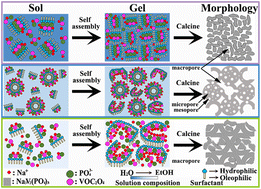Pore-forming mechanisms and sodium-ion-storage performances in a porous Na3V2(PO4)3/C composite cathode†
Abstract
Na3V2(PO4)3 (NVP) is regarded as one of the most promising cathode materials for sodium-ion batteries (SIBs). However, it suffers from a dense bulk structure and low intrinsic electronic conductivity, which lead to limited electrochemical performances. Herein, we propose a surfactant-assisted molding strategy to regulate the pore-forming process in NVP/C composite cathode materials. More precisely, the forming process of the pores in NVP could be easily controlled by utilizing the huge difference in critical micelle concentration of a surfactant (cetyltrimethylammonium bromide, CTAB) in water and ethanol. By reasonably modulating the ratio of water and ethanol in the solution, the as-synthesized NVP/C sample exhibited a three-dimensional interconnected structure with hierarchical micro/meso/macro-pores. Benefiting from these hierarchical porous structures in NVP/C, the structural stability, contact surface with the electrolyte, and electronic/ionic conductivity were improved simultaneously; whereby the optimized porous NVP/C sample exhibited an excellent high-rate performance (61.3 mA h g−1 at 10 C) and superior cycling stability (90.2% capacity retention after 500 cycles at 10 C).



 Please wait while we load your content...
Please wait while we load your content...